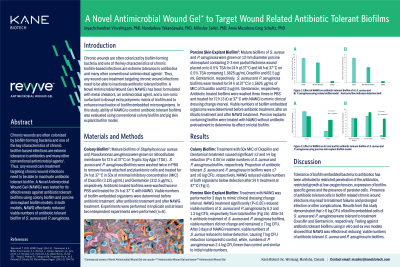Laboratory Research
(LR-026) A Novel Antimicrobial Wound Gel to Target Wound Related Antibiotic Tolerant Biofilms

Methods:
Mature biofilms of Staphylococcus aureus and Pseudomonas aeruginosa were grown on nitrocellulose membrane or porcine skin explant for 72 h at 37°C. S. aureus and P. aeruginosa Biofilms were washed twice in PBS to remove loosely attached and planktonic cells and treated for 24 h at 37°C in 50X of minimal inhibitory concentration (MIC) of Oxacillin and Gentamicin, respectively. Antibiotic treated biofilms were washed twice in PBS and treated for 24 h at 37°C with NAWG. Viable numbers of biofilm embedded organisms were determined before antibiotic treatment, after antibiotic treatment and after NAWG treatment.
Results: Treatment with 50x MIC of Oxacillin and Gentamicin treatment caused significant ≥2 and ≥4 log reduction (P ≤ 0.05) in viable numbers of S. aureus and P. aeruginosa biofilm, respectively. Proportion of antibiotic tolerant S. aureus and P. aeruginosa in biofilms were ≥7 and ≥6 log CFU, respectively. NAWG reduced viable numbers of both organisms below detection after 24 h treatment at 37°C when tested using colony biofilm model. Significant reductions in viable numbers of both organisms were also noted when tested using Porcine skin explant model.
Discussion: Tolerance of biofilm embedded bacteria to antibiotics has been attributed to restricted penetration of the antibiotics, restricted growth at low-oxygen tension, expression of biofilm-specific genes and the presence of persister cells. Presence of antibiotic tolerant cells in biofilm related chronic wound infections may lead to treatment failures and prolonged infection or other complications. Results demonstrated that ≥ 6 log CFU of biofilm embedded cells of S. aureus and P. aeruginosa were tolerant to treatment with 50 x MIC of Oxacillin and Gentamicin, respectively. Testing against antibiotic tolerant biofilms using in vitro and ex vivo models showed that NAWG was effective at reducing viable numbers of antibiotic tolerant S. aureus and P. aeruginosa in biofilms.
Trademarked Items:
References:

.png)